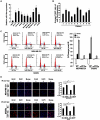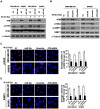miR-18a impairs DNA damage response through downregulation of ataxia telangiectasia mutated (ATM) kinase
- PMID: 21980462
- PMCID: PMC3181320
- DOI: 10.1371/journal.pone.0025454
miR-18a impairs DNA damage response through downregulation of ataxia telangiectasia mutated (ATM) kinase
Abstract
The DNA damage response (DDR) encompasses multi-step processes by which cells evolve to sense DNA damage, transduce the signal and initiate the repair of damaged DNA. Ataxia Telangiectasia Mutated (ATM) Kinase, which functions as the primary sensor and transducer of DNA damage signal, has been demonstrated to play an important role in the DDR and cancer prevention. Hence, understanding the molecular mechanisms underlying the regulation of ATM has received much attention. Here, we found that miR-18a was upregulated in both cell lines and patients' tissue samples of breast cancer. Furthermore, we demonstrated that ectopically expressing miR-18a downregulated ATM expression by directly targeting the ATM-3'-UTR and abrogated the IR-induced cell cycle arrest. Similar to the effect of ATM siRNA, overexpressing miR-18a in breast cancer cells reduced the DNA damage repair ability and the efficiency of homologous recombination-based DNA repair (HRR) and sensitized cells to γ-irradiation (IR) treatment. However, inhibition of miR-18a led to augmentation of DNA damage repair, increase of HRR efficiency and reduced cellular radiosensitivity. Moreover, we showed that the phorsphorylation level and nuclear foci formation of H2AX and 53BP1, the downstream substrates of ATM kinase, were significantly deceased in miR-18a overexpressing cells. Taken together, our results uncover a new regulatory mechanism of ATM expression and suggest that miR-18a might be a novel therapeutic target.
Conflict of interest statement
Figures





Similar articles
-
MicroRNA-18a attenuates DNA damage repair through suppressing the expression of ataxia telangiectasia mutated in colorectal cancer.PLoS One. 2013;8(2):e57036. doi: 10.1371/journal.pone.0057036. Epub 2013 Feb 21. PLoS One. 2013. PMID: 23437304 Free PMC article.
-
ATM-dependent MiR-335 targets CtIP and modulates the DNA damage response.PLoS Genet. 2013 May;9(5):e1003505. doi: 10.1371/journal.pgen.1003505. Epub 2013 May 16. PLoS Genet. 2013. PMID: 23696749 Free PMC article.
-
MicroRNA-18a upregulates autophagy and ataxia telangiectasia mutated gene expression in HCT116 colon cancer cells.Mol Med Rep. 2013 Feb;7(2):559-64. doi: 10.3892/mmr.2012.1214. Epub 2012 Dec 3. Mol Med Rep. 2013. PMID: 23229340
-
Harmonising the response to DSBs: a new string in the ATM bow.DNA Repair (Amst). 2005 Jul 12;4(7):749-59. doi: 10.1016/j.dnarep.2004.12.008. Epub 2005 Jan 27. DNA Repair (Amst). 2005. PMID: 15978533 Review.
-
ATM and the molecular pathogenesis of ataxia telangiectasia.Annu Rev Pathol. 2012;7:303-21. doi: 10.1146/annurev-pathol-011811-132509. Epub 2011 Oct 24. Annu Rev Pathol. 2012. PMID: 22035194 Review.
Cited by
-
Comparison of miRNA Expression Profiles between HIV-1 and HIV-2 Infected Monocyte-Derived Macrophages (MDMs) and Peripheral Blood Mononuclear Cells (PBMCs).Int J Mol Sci. 2020 Sep 22;21(18):6970. doi: 10.3390/ijms21186970. Int J Mol Sci. 2020. PMID: 32971935 Free PMC article.
-
MicroRNAs, DNA Damage Response, and Cancer Treatment.Int J Mol Sci. 2016 Dec 12;17(12):2087. doi: 10.3390/ijms17122087. Int J Mol Sci. 2016. PMID: 27973455 Free PMC article. Review.
-
The miR-181 family promotes cell cycle by targeting CTDSPL, a phosphatase-like tumor suppressor in uveal melanoma.J Exp Clin Cancer Res. 2018 Jan 30;37(1):15. doi: 10.1186/s13046-018-0679-5. J Exp Clin Cancer Res. 2018. PMID: 29382357 Free PMC article.
-
microRNAs: An Emerging Paradigm in Lung Cancer Chemoresistance.Front Med (Lausanne). 2015 Nov 4;2:77. doi: 10.3389/fmed.2015.00077. eCollection 2015. Front Med (Lausanne). 2015. PMID: 26583081 Free PMC article. Review.
-
miR-17-92 fine-tunes MYC expression and function to ensure optimal B cell lymphoma growth.Nat Commun. 2015 Nov 10;6:8725. doi: 10.1038/ncomms9725. Nat Commun. 2015. PMID: 26555894 Free PMC article.
References
-
- Harper JW, Elledge SJ. The DNA damage response: ten years after. Mol Cell. 2007;28:739–45. - PubMed
-
- Myung K, Datta A, Kolodner RD. Suppression of spontaneous chromosomal rearrangements by S phase checkpoint functions in Saccharomyces cerevisiae. Cell. 2001;104:397–408. - PubMed
-
- Zhou BB, Elledge SJ. The DNA damage response: putting checkpoints in perspective. Nature. 2000;408:433–439. - PubMed
-
- Jiri Bartek, Jiri Lukas. Chk1 and Chk2 kinases in checkpoint control and cancer. Cancer Cell. 2003;3:421–429. - PubMed
-
- Weinert T, Lydall D. Cell cycle checkpoints, genetic instability and cancer. Semin Cancer Biol. 1993;4:129–140. - PubMed
Publication types
MeSH terms
Substances
LinkOut - more resources
Full Text Sources
Research Materials
Miscellaneous

